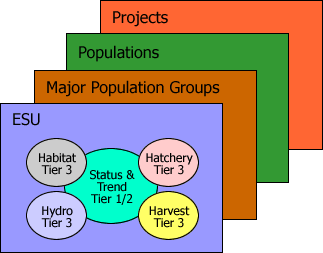CSMEP Monitoring Integration
Representatives from each of the five CSMEP workgroups are exploring the integration of the individual RME component parts within a larger monitoring framework (i.e., seeking to generate improved efficiencies through integrated designs) for the Snake Basin Pilot Design. Integration of M&E across scales and topic areas, illustrated in the figure below, is a challenge faced by all subbasins; hence the results from the CSMEP pilot will be of general benefit Columbia Basin-wide.

Integration of M&E across spatial scales and monitoring workgroups in the Snake Basin Pilot Study.
The group has begun to develop a comprehensive matrix of shared performance measures and data interdependencies across the different CSMEP subgroups. The matrix is providing a starting foundation for identifying the priority performance measures for monitoring and the relevant spatial scales of these data for varied subgroup monitoring needs.
The group is also pursuing a simulation analysis to assess the cost/benefit of a large integrated PIT-tagging program designed to address a range of key monitoring questions across the subgroups. The ultimate intent is to evaluate what intensities of basin-wide PIT-tagging (and at what life-stages) would/would-not-be sufficient to achieve adequate statistical power at reasonable cost to address the suite of subgroup questions at various spatial scales. The Integration Workgroup will be working to further refine this analysis and intends to extend this approach into other sampling protocols that have the potential for integration across all subgroups.
The Integration Workgroup also developed a Survey of Monitoring Questions intended to obtain information from policy-level personnel on the relative importance of monitoring questions across various spatial scales for six listed stocks of focus in CSMEP: spring/summer Chinook salmon, fall Chinook salmon, steelhead trout, sockeye salmon, coho salmon, and bull trout. The survey was designed to identify priorities in data needs for monitoring the status and trends of listed fishes, as well as the effectiveness of habitat, harvest, hatchery and hydrosystem actions. CSMEP scientists will use this information obtained from this survey to further guide their work on developing integrated monitoring designs.